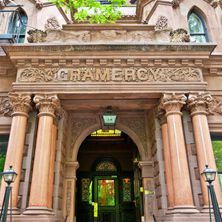

Gramercy Park is without doubt the most charming of all parks in New York City. But it is not easy getting inside. In fact, if you are not a resident of the encircling Gramercy Park Historic District, it is impossible. At most you will be allowed to stroll or jog around the fenced-in park, but only residents that live in the surrounding 39 buildings have a key, which costs between one and two thousand dollars to replace.
Gramercy Park is not a large park. By New York standards it is actually very small: about two acres. It lies at the north end of the Gramercy Park Historic District, which is nestled in an irregular area, outlined, roughly, by 21st Street in the north, 18th Street in the South, Park Avenue in the west and Third Avenue in the east.
The park was developed in the 1830s by New York lawyer and politician Samuel B. Ruggles, who had bought the land from the municipal government. The name Gramercy is an Anglicized version of the Dutch "Crommessie," which in turn derived from "Krom Moerasje," meaning "little crooked swamp." When Ruggles acquired the land, he had to drain and fill in a swamp and brook that were present on the territory. Some of the elegant Greek Revival-style townhouses that we see around the park today date to the middle of the 19th century.
In the summer of 1863, during the American Civil War, Gramercy Park witnessed a series of violent public tumults known as the New York City draft riots. Working-class New Yorkers who could not afford to pay the $300 commutation fee to hire a substitute protested against the laws passed by Congress drafting men to fight in the war. The riots were put down by the soldiers from the Union army who were stationed in the park. As a result 120 people died and over 2,000 were injured. The draft riots are considered the largest civil insurrection in the history of America.
Towards the end of the 19th century the Gramercy district had become an exclusive neighborhood for the city's elite. To own a townhouse there meant possessing important status. Influential businessmen, politicians, philanthropists and cultural figures resided in the area. Theodore Roosevelt, the 26th President of the US, and one of the most popular in the country's history, was born on 20th Street, between Park Avenue and Broadway. In 1847, on the southern side of the park, at the address of 16 Gramercy Park, illustrious Shakespearean actor Edwin Booth founded the Players Club. The mansion that housed the social club had been built in 1844 and Booth kept the upper floor for his apartment. Booth was one of the best actors of the day, however, his professional reputation was overshadowed by his fraternal relation to John Wilkes Booth, the man who had assassinated President Abraham Lincoln in Washington D.C. in 1865. A bronze statue dedicated to Edwin Booth in the role of Hamlet was erected in Gramercy Park in 1918.
Just below the park is a characteristic street called Irving Place. It is lined with tasty international restaurants and cafes and at the turn of the 20th century was the most coveted residential street in the neighborhood, due to its convenient location between Gramercy Park and Union Square on 14th Street. At the corner of Irving Place and 18th Street is a pub called Pete's Tavern. It was here that in 1905 legendary American writer O. Henry conceived and possibly even wrote his short story, The Gift of the Magi.
On the northern side of the park, at the western corner of Lexington Avenue and 21st Street, stands the Gramercy Park Hotel, built in 1925 in Renaissance Revival Style. In the first half of the 20th century it was one of the most famous hotels in downtown Manhattan. Members of the Kennedy family stayed there for several months, as well as famous Hollywood movie stars. Humphrey Bogart even married his first wife on the premises. In the 1970s it became a popular hideout for rock musicians such as Bod Dylan, David Bowie, Bob Marley and Debbie Harry from Blondie.
Gramercy Park and the surrounding historic district have preserved not only the aspect but also the rhythm of old New York. As we approach the park's iron fence, we feel the train of modern metropolis life coming to a halt. The park is off limits to tourists and most New Yorkers alike. We understand that there is something special about it. It is a so-called urban reservation. It guards something. History.